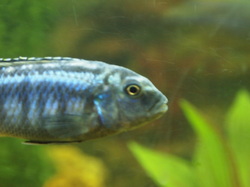
The first african cichlid i had in my 80 gal tank was an Electric Blue Johanni. his name was Congo. Male johannis' are a stunning blue while females are a bright yellow. these fish are on the more aggressive side of cichlids. These saffron and turquoise beauties hail from the east part of lake Malawi , near Tanzania and Mozambique. Its scientific name is Melanochromis Johanni. it should be kept with other aggressive mbuna cichlids such as zebras and kenyi.
These cichlids are very popular in the hobby, and isn't very rare to find in chain pet stores such as petsmart. they are easily identified by a turquoise blue color that range from very bright to almost grey , and black horizontal lines in males as well as a black " M " shape between its eyes , Females are often smaller and light yellow. Johannis have round cylindrical bodies. This fish is stubbornly territorial so it must have its own space in the tank that it can claim as its own. Electric blue johanni cichlids are mouth brooders . the female will carry a clutch of eggs for around 28 days.
General information about this species
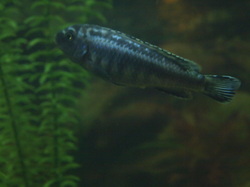
Water hardness : hard
PH: 7.5 to 8.5
Behavior: very aggressive and verry territorial
Size: about 5 inches
Water temperature: 76 to 82 degrees Fahrenheit
Demand in the hobby: high and very common
Price Range : 15.00 ( what i paid for mine )
this is not a fish for beginners despite its availability
This is a dedication.
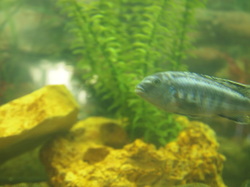
<---- Congo, my first electric blue johanni male , just recently past for what we think were internal injuries or complications from a fight , or perhaps a genetic defect , he spontaneously stopped eating and got thinner and thinner , he would eat when he could but if the other fish were around he would back down , Congo showed no sign of disease , and lived like this for two months before finally succumbing to either his tank mates or something else. we've watched for disease symptoms and nothing has surfaced. like it should have after a two month wait.I have just recently added another electric blue ,another strapping male with a sea blue body and an iridescent turquoise face. RIP Congo.
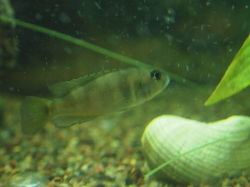
<-- this handsome fellow here is a neolamprologus meeli shell dwelling cichlid from Lake Tanganyika (Lake Tanganyika is the second largest freshwater lake in the world and houses 250 cichlid species most of which live at a depth of 590 ft ) N. Meeli is a somewhat rare shell dweller. all though not very colorful, these fish make a wonderful addition to an African Cichlid/ Tanganyikan tank. these guys lay there eggs in shells and when bearing will avidly guard the shell there brood is in. N. Meelis' as well as most shell dwellers , don't just claim one shell , they claim many. and These guys mate for life.
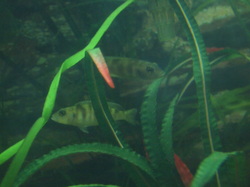
This is my mating pair the female is the lighter of the two -------> the male is the darker shown above ^ and with his mate > There names are Eros and Psyche named after the Mythological couple . Eros ( the alternative name for cupid ) is the male and psyche id the female. Meelis' are known to breed well after a couple has established itself , but if stressed will eat their own young. When we purchased Eros and Psyche they had been guarding a shell... soon after they came home they stopped , we had brought the shell home in hopes that the babies would survive. They didn't. Now however, we are once again expecting another brood ,
These fish are very strong and I've watched them pic up a shell 3 times there size and move it to safety. These are some of my very favorite fish in my tank . despite not having very much color they are very unique and a rather rare find
General Information about this species
Water hardness : hard
PH: 7.5 to 8.5
Behavior: mildly aggressive , very aggressive with presence of eggs or fry
Size: 4 to 7 cm ( about 2 inches )
Water temperature: 73 to 82 degrees Fahrenheit
Demand in the hobby: low
Price Range : 7.00 ( what i paid for each for mine )
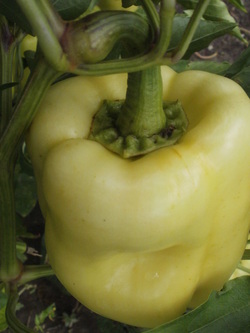
It may seem like a weird title for a blog post. You may be asking how do you recycle aquarium water? or is it paper, metal, glass or plastic? well before you pour your aquarium water down the drain. consider everything your wasting, fish tank water contains all kinds of key nutrients that will go to waste if not used. Waters your gardens and house plants with natural organic , aquarium waste, instead of mixing fresh "clean" water with chemicals that can burn your plants roots if mixed to strong.
PLEASE NOTE: if your tank has recently been treated for a disease your aquarium water probably shouldn't be used to water plants. also Marine water (saltwater), shouldn't be used.
For further reading:
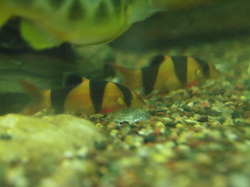
When I first started keeping fresh water fish i thought it would be easy, but it wasn't. The hobby that is aquariums is like mixing keeping a family pet with skill and together this thing becomes its own unique art form, full of learning and delight. Betta fish after betta fish I slowly learned the common diseases in fresh water , how to identify them , and how to cure/prevent them. most of the times , as i was very young and working in small unfiltered tanks , i lost my fish , one betta died of ich , one of a bacterrial infection and one of cotton wool fungus , ( please keep in mind that this is over 6 years, a bettas life span is around 2 -3 years) i tried every cheap treatment on the shelves and nothing ever quite helped. so i stopped keeping bettas, it was just me and Gish who has never had any problems for the longest time. recently I've dealt with fin rot and ich, and cotton wool in the big tank (80 gal), All of them cured with no fish lost. The secret is the heater , slightly raising the temperature of the tank must have been the key because its the only thing i did diffrently, it was at 79 degrees so i raised it to 82 added some aquarium salt and the fish drug of choice ( for ich i used mardel's quick cure *Note* this stuff is very harsh , but works *) (also follow the directions on the bottle). i never had heated any of my tanks before so i now had a new tool to utilize. another tip for disease is to catch it early. It is always wise to keep a test kit , these are very expensive but worth the money. ive been slowly building my test kit , because i dont need a hardness test kit ... my water is very hard and i know that, it never changes. i suggest getting one of these however if your water does not come from a natural well or is ran through a water softener. test kits are valuable because most tanks will go through a cycle, this is when the ammonia spikes ungodly high and kills everything. letting your ammonia get out of control like that i don't think is necessary , in fact , it never happened in my tank. its very wise especially in a cichlid tank to buy a filter that is much larger than what is recommended for the tank. (such as i have and 80 gal aquarium with a filter for a 110 gal aquarium ) Then before you put fish in the tank let the water cycle through the filter from 1 -2 weeks ( some people do 3 just to be safe) ,then it should be safe for the fish
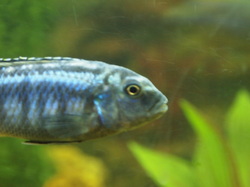
The first weeks of having the tank are very critical. as this is when most diseases will appear , in newly stressed out fish. this is also a problem after water changes and when adding new fish. ADD STRESS COAT! it may seem like it does nothing. but it restores the fishes protective slime coat.
When i first started i had a planted tank. Planted tanks aren't for beginners, everything died except for 1 java fern plant that was moved to Gish's bowl. Plants depend on certain kinds of lighting , which i apparently did not have.
One thing i did not expect when i started the 80 Gal aquarium was the price. Small scale aquariums are inexpensive but considerably harder to keep up with. A large aquarium is pricey but is easy to clean ( warning you get a little wet!) and achieves a stability after a while that is only changed after a water change which doesn't happen but 4-6 times a year ( this really depends on how many fish you have). My tip is to buy your tank and cabinet used. we paid 300 for our 80 gal and cedar cabinet , this is a 900 dollar value. most of your money will go into the tank its self , with stabilization ,fish,and medical costs. it is an expensive hobby ... but it don't seem like it is , costs add up. a 20 dollar fish is only a 20 dollar fish till you buy 18 of them... then things start getting up there in price. so acquire things slowly and eventually complete your fish empire!
-Pisces








 RSS Feed
RSS Feed